wrestling / Columns
The Magnificent Seven: The Top 7 Dustin Runnels Moments
Despite never winning a world title, and never having more than cup of coffee at the main event level, I would argue that Dustin Runnels is one of the most important and most under-celebrated professional wrestlers of the past twenty-five years. Whether he was performing as Dustin Rhodes, Goldust, The Artist Formerly Known as Goldust, Seven, or Black Reign, Runnels innovated, performed at a high level, and demonstrated remarkable longevity and versatility to remain relevant across different eras and trends, a mid-card fixture and consistent contender for secondary championships for more or less the duration of his career. So, in homage to Runnels, this week I’m looking back at his top seven moments.
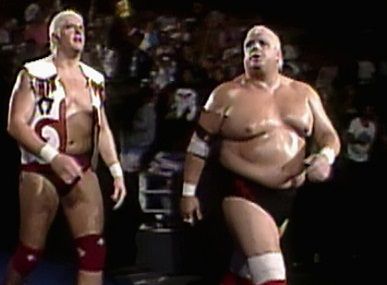
#7. Debuting Opposite Ted Dibiase
Dustin Rhodes debuted on the national stage in 1990, when his father brought him into WWF to wage war with Ted Dibiase. The program that followed was a near-perfect introduction to everything the younger Rhodes would be in the pre-Goldust years—a kid with a gumption who wouldn’t abide getting bullied.
Dibiase claimed Rhodes couldn’t last ten minutes in the ring with him. Thus, a special challenge was set—a match in which Rhodes could win by any conventional means—pin fall, submission, count out, or DQ–or by simply surviving to the ten-minute mark. The match paid tribute to and protected Dibiase as an upper card talent—they established that it would be an accomplishment for the rookie to last ten minutes with The Million Dollar Man, thus establishing a win-win scenario in which Rhodes did go the distance, and though Dibiase technically lost, he didn’t have to eat a fall.
Fewer folks remember the follow-up tag bout at the Royal Rumble in which the Rhodes’s father-son team challenged Dibiase and Virgil, but that aspect of the program worked as well, as Dustin and Dusty remained underdogs and common men in defeat, not to mention that they successfully put over Dibiase on their way out the door to WCW.
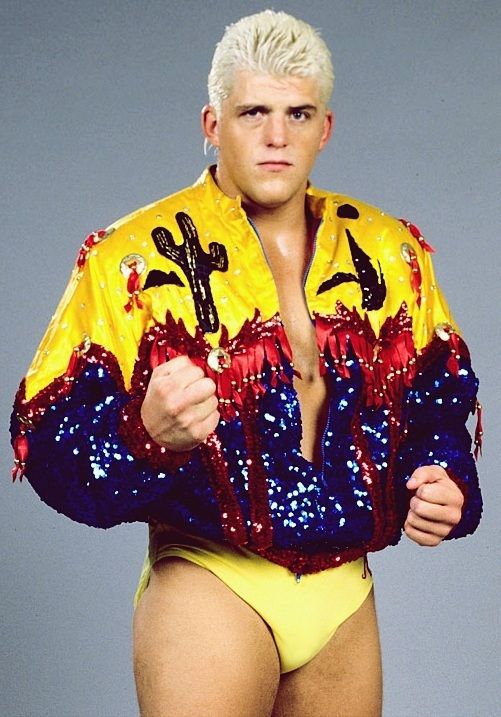
#6. War Games 1993
When people reflect on Fall Brawl 1993 and the main event War Games match, they tend to focus on The Shockmaster’s disastrous run—his mortifying debut leading up to the match, and winning for his team at War Games despite the rose already having fallen off the bloom for his WCW run. There’s another, far better, subplot that is too often overlooked, and that’s Dustin Rhodes’s courageous choice to storm the cage.
You see, in the build to War Games, the heels had gotten the better of Rhodes, injuring him to the point that the face team wanted to protect him by keeping him out of the match for as long as possible. Rhodes rejected this notion, eager to prove himself and to seek revenge. Thus, while they tried to decide who would start the match, Rhodes impulsively snuck past his teammates, into the cage, to the get things started against Vader. Thus, we had an inexperienced and pre-hurt hero fighting his way through the duration of War Games, planting a red herring that he might be the one who lost the match for his team, while simultaneously putting over Rhodes as one tough bastard.
I’m not going to pretend that WCW fully capitalized on these dynamics—I think it’s fair to say Rhodes got in way too much offense on Vader, and that the commentary team didn’t properly sell the gravity of his situation. Just the same, it was a good performance to establish Rhodes as a player on a similar level to his more established teammates, Sting and Davey Boy Smith.
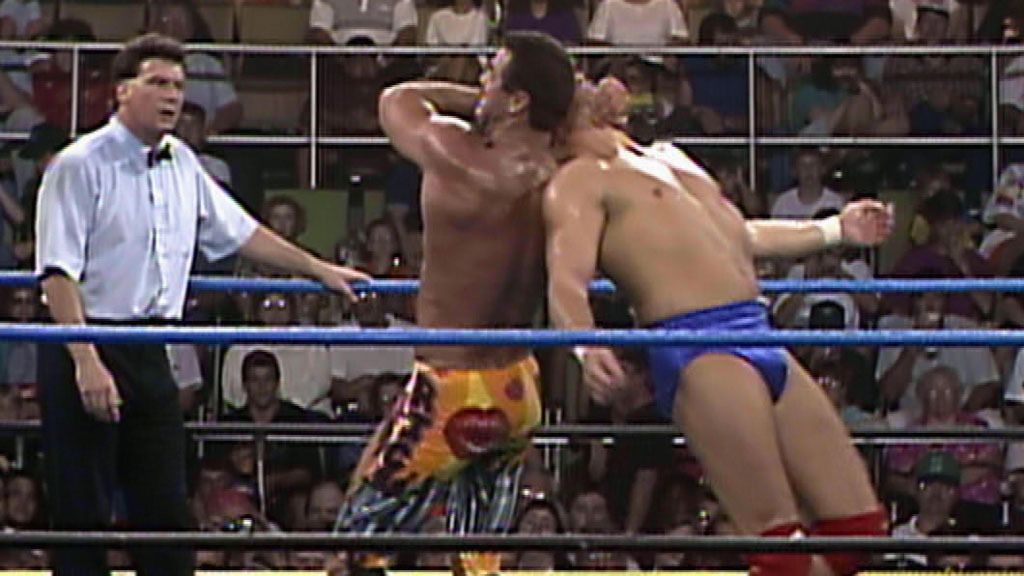
#5. Feuding with Rick Rude
I’ll admit that I’m stretching the term “moment” with this entry, and if I had to put a finer point on it, I’d narrow to the Dustin Rhodes-Rick Rude Iron Man Match at Beach Blast 1993.
Keeping the broader perspective, though, the program with Rude was among Rhodes’s first major singles feud with a major star after earning his stripes in the tag team ranks. Rude was a borderline main eventer, and in going toe to toe with him, the United States Championship at stake, Rhodes established himself as a likely candidate for the main event in years ahead. The feud told a good, basic story of a more established, arrogant heel, beating back a humble young Texan who was trying to fight his way through the glass ceiling. The resulting matches demonstrated solid ring work, highlighted by a forgotten gem of an Iron Man Match that was probably a little too dependent on rest holds, but that just the same told a compelling story, and felt special for the stipulation.
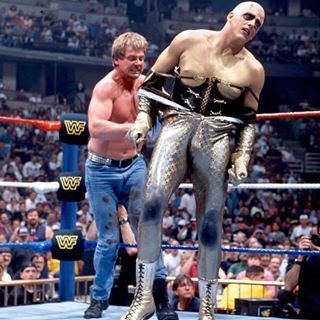
#4. The Backlot Brawl
It’s often been said that the Goldust character was ahead of its time and a vanguard for the more risqué programming of the Attitude Era. I’d support that interpretation, and moreover I’d argue that this match may have done a better job than any other of encapsulating and foreshadowing the Attitude Era a year or two before it launched in earnest.
For the unfamiliar, the build to WrestleMania 12 saw Goldust grow progressively weirder, more abstract, and more homoerotic—all in more overt and more aggressive ways than the WWF had previously entertained. He landed in the crosshairs of WWF President Roddy Piper. Thus the two were booked in a Hollywood Backlot Brawl. While WrestleMania 10 had already initiated WWF fans to hardcore and falls count anywhere scenarios as exhibited in Randy Savage-Crush, the concept was still in its infancy. In an age before fights in the locker room and the concession stands became a part of the Attitude scenery, staging a match in parking lot behind the arena was still a significant anomaly.
The match to follow was nothing if not unconventional—a very nicely executed outdoor brawl, followed by what I can only assume was wrestling’s first high speed car chase , culminating in Piper and Goldust making their back to the arena and duking it out once and for all in the ring.
The match has its flaws—the freeway OJ Simpson parody largely silly, Goldust wearing women’s lingerie reading like a bit of a homophobic non-sequitur, the absence of a pin fall or submission leaving questions as to why we should accept the match was over. It was, however, also a groundbreaking hardcore style brawl that took place on the biggest show of the year, carried out by a pair of highly skilled veterans who got as much out of the concept as anyone could really hope for. It was, therefore, the essence of Dustin Runnels—breaking ground, innovating, and entertaining within the limitations the bookers saddled him with.
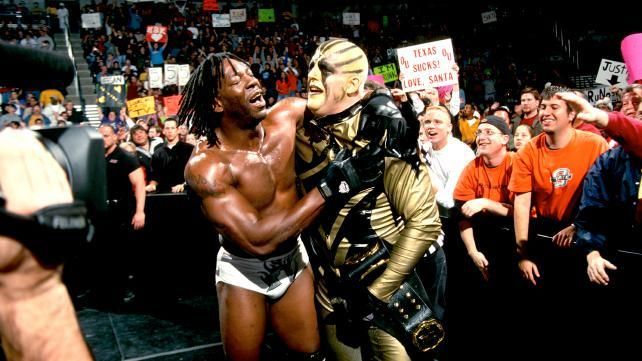
#3. Teaming with Booker T
Again, I’ll concede that I’m stretching the definition of a “moment.” Just the same, Goldust’s time aligned with Booker T represents some of the very best work of his career, and another great example of Runnels making the best of a middling situation.
The pairing of Booker T and Goldust probably should have gone down as one of the many forgettable and uninteresting odd couple pairings that wrestling promotions have dabbled in for decades. They emerged as something greater, though—the lone tandem that I would argue rivals The Rock N Sock Connection and Team Hell No’s odd-couple-that-is-wildly-comedic-but-still-an-effective-threat chemistry.
Booker T and Goldust joined forces when Goldust, a largely directionless mid-card vet, got drafted to the Raw brand. Booker was just coming into his own as a serious singles performer and upper card face in the context of the WWF, and joining the team initially seemed like a step backward for him. The two promptly hit their stride, though—Booker the straight man, Goldust a toned down but no less wacky incarnation of his old character who perfectly set up his partner to be indignant. Hijinks and tag team gold ensued, leading to the first meaningful bend in the story when the nWo inducted Booker, but not Goldust into their ranks. Herein the magic really began, as Booker played brilliantly conflicted and Goldust, obviously the lesser in-ring talent, vacillated from sidekick to victim before the team got back together to combat the nWo crew. Booker and Goldust rekindled a similar dynamic when Booker graduated to the main event scene to challenge Triple H, and the build saw Helmesley’s Evolution stablemates incapacitate Goldust to add some much needed heat to the program.
In the months to follow, Goldust took on a stutter and, in questionable taste, acted as though he had contracted Tourette’s Syndrome as a result of an Evolution attack. Say what you will about the storyline—it offered Goldust yet another platform to play an unconventional character with tremendous skill and attention to detail.
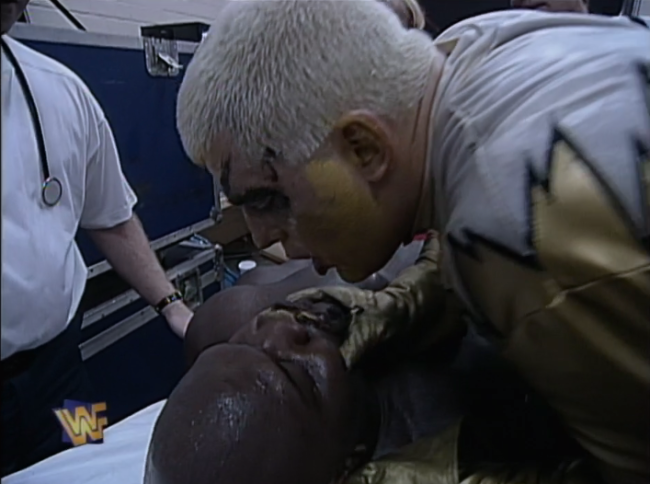
#2. Giving Ahmed Johnson Mouth-To-Mouth
While Goldust lost the war to Roddy Piper at WrestleMania 12, he remained the Intercontinental Champion and his gimmick of playing homoerotic mind games with other wrestlers only grew more entrenched in his flamboyant persona. This specific brand of heel chicanery made Goldust the perfect foil for blue-chip newcomer Ahmed Johnson.
Johnson had exploded onto the scene and his entire gimmick was devoted to being a super powerful badass. To that point, he had destroyed a spectrum of jobbers, feuded Jim Cornette’s charges (which included body slamming Yokozuna in one of his first televised appearances), and gotten the best of the more cartoonish Jeff Jarrett. A run at the Intercontinental Championship looked to be the next step in legitimizing Johnson as he climbed toward the main event.
Looking back, Johnson is something of a footnote in the New Generation Era—an also-ran whose poor timing (coming up alongside Shawn Michaels), legitimate health issues (kidney problems that sidelined on what may have been the cusp of a main event), alleged bad attitude, and getting lost in a quagmire of Nation of Domination booking rendered him woefully forgettable. But taken in his own context, at his peak in 1996, Johnson looked unstoppable.
Thus, it was nearly unthinkable when Goldust insisted giving on Ahmed Johnson mouth-to-mouth resuscitation when he was unconscious backstage. In retrospect, Johnson’s righteous indignation comes across as a little homophobic, but in the context of a mid-1990s wrestling show, watching the company’s biggest badass react to the company’s biggest sleaze shoving his tongue down his throat was pure gold. Beyond pursuing his first title, Johnson had all the just cause he needed to not just challenge Goldust but to annihilate him at that June’s King of the Ring.
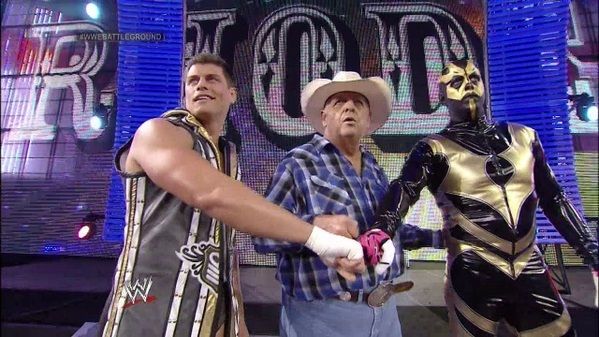
#1. Representing The Rhodes Family at Battleground 2013
In early 2013, it was perfectly reasonable to think you had seen the last of Goldust. Runnels had, by then, completed two solid runs in WWE, two solid runs in WCW, a most recent stint in TNA during which he showed his age and looked ready to recede to working indy spots, and perhaps making the occasional mainstream wrestling cameo before he truly rode off into the sunset.
But behind the scenes, Runnels was getting ready.
From Runnels’s own accounts, he took on a regimen of DDP Yoga that not only eased his body’s pain after over twenty years in the ring, but restored him to arguably better shape than he had been in at any point in the preceding decade. Thus, the stage was set for another major run. And boy did WWE have a doozy in store.
At SummerSlam 2013, WWE pressed the reset button on so much of its programming at the time. Triple H turned heel to give the promotion a new heel authority figure. Randy Orton turned heel to become the new heel world champion. The Shield settled into a new role, arguably one step down the card, as The Authority’s security and henchmen.
And then there were the forces of good. After beating John Cena and having his newly won world title stolen via Money in the Bank, Daniel Bryan led the charge. Big Show and Dolph Ziggler settled in as upper-card faces right behind him. And then there was Cody Rhodes.
After wandering the mid-card for an extended stretch, Rhodes landed himself in a personality clash with Randy Orton. As a move toward cementing the new Authority regime, this led to an Orton-Rhodes bout with Rhodes’s job on the line. Rhodes put up a good fight, but was ultimately no match for the champ.
The weeks to follow saw Dusty Rhodes plead for his son’s job, and then Goldust resurfaced to speak on behalf of his half-brother. The Rhodes family’s talents as not only in-ring performers, but all the more so great talkers were on full display in this emotional story arc, which culminated in the Rhodes brothers, with Dusty in their corner, challenging Seth Rollins and Roman Reigns at Battleground. At stake: the Shield members’ tag straps versus the Rhodes boys’ WWE contracts. After an iconic three-man promo from the Rhodes family, the half-brothers put on one of the very best matches of 2013—a hidden gem amidst an otherwise bad PPV—to strike back against The Authority, win back their jobs, and claim tag title gold.
I appreciate the many ends this match accomplished. It celebrated the legacy of The American Dream. It offered a showcase for the new and improved Goldust. It (at least theoretically) elevated Cody Rhodes as the centerpiece of the angle, edging him toward a main event spot. Moreover, even in defeat, Rollins and Reigns grew that much more established in this match as top-tier performers and heels.
In the long-run, the brothers Rhodes wouldn’t rise any higher, but did have an extended run as a team which lent some stability and legitimacy to an inconsistent subsection of the WWE roster, and, for better or worse, paved the way for the Stardust character.
Which Dustin Runnels moments would you add to the list? Let us know what you think in the comments section.
Read more from Mike Chin at his website and follow him on Twitter @miketchin.







